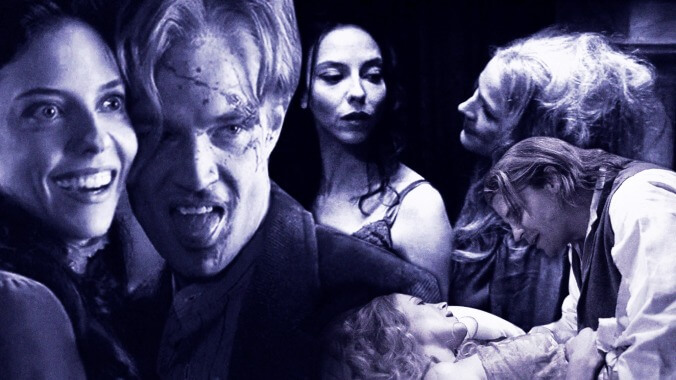On Buffy The Vampire Slayer, characters could be queer and supernatural
Buffy’s bisexual vampire foursome the Whirlwind is just as significant to its depictions of queerness as Willow and Tara
Image: Graphic: Allison Corr
Nearly 25 years since its debut in 1997, Buffy The Vampire Slayer remains one of the most celebrated series when it comes to early depictions of queerness on television. When lesbian witches Willow (Alyson Hannigan) and Tara (Amber Benson) first kissed in “The Body”, it marked the beginning of one of the first long-term lesbian relationships on American TV. Though the debate rages on about whether or not Willow and Tara make for good representation, the prevalence of queer characters on Buffy The Vampire Slayer sets it apart from many of its contemporaries. Even non-canon couples like Faith (Eliza Dushku) and Buffy (Sarah Michelle Gellar) have ardent sects of fan support, and make for compelling allegorical examples of the queer experience—a narrative mostly unexplored by the vast majority of its contemporaries.
But while discussions abound about the strides for lesbian visibility made by Buffy The Vampire Slayer, many academic and fan conversations surrounding queerness and representation on the show often neglect to mention the four queer characters who made up the Whirlwind. Composed of Angel (David Boreanaz), Spike (James Marsters), Darla (Julie Benz), and Drusilla (Juliet Landau), the Whirlwind was a quartet of mischief-making bloodsuckers who put a twist on the longstanding tradition of using vampirism as code for queerness. Crucially, though, the vamps on Buffy aren’t just coded as queer— they’re canonically bisexual. Darla and Dru even had a threesome with The Immortal in Angel’s “The Girl In Question.” That revelation is either ignored by fans or simply unknown to more casual viewers because of how little fanfare their bisexuality garners over the course of the series. Despite falling into some unfortunate cliches in horror and fantasy media, the Buffyverse’s presentations of vampire sexuality offered early examples of queerness being treated with the kind of casualness that most queer couples aren’t afforded in modern media.
Many authors have opted to use science-fiction and horror/fantasy elements to queer-code their characters, masking them beneath “otherness” and spectacle to throw mainstream readers off the scent, while still being recognizably queer enough to appeal to LGBTQ+ audiences. Authors and filmmakers have used every creature from cat people to shapeshifting aliens to code characters as queer, but no other sci-fi, horror, or fantasy creature has such notorious and longstanding ties to queerness as the vampire. Beginning with Sheridan Le Fanu’s lesbian vampiress Carmilla, continuing on through Bram Stoker’s Dracula, and skyrocketing in popularity with Anne Rice’s Interview With The Vampire and the subsequent film adaption, the queer-coded vampire is a staple of early LGBTQ+ characterization. But Buffy The Vampire Slayer takes the coding out of the equation entirely and presents audiences with four bisexual vampires, an updated but imperfect approach to queer characters in horror and fantasy.
It’s worth noting that all of the major LGBTQ+ characters on Buffy The Vampire Slayer are “others” in some capacity—Willow and Tara are witches, Kennedy is a Slayer, and, of course, the four members of The Whirlwind are all vampires. The choice to make only non-human characters canonically queer carries on the tradition of using mysticism as code for queerness; on Buffy, characters are allowed to be both supernatural and queer.
